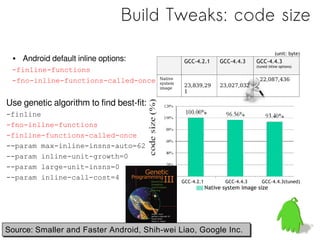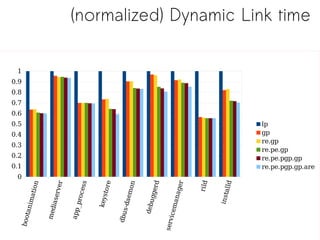Ad
olibc: Another C Library optimized for Embedded Linux
- 1. olibc: Another C Library optimized for embedded Linux Jim Huang ( 黃敬群 ) <[email protected]> Developer, 0xlab Feb 22, 2013 / Embedded Linux Conference
- 2. Rights to copy © Copyright 2013 0xlab http://0xlab.org/ [email protected] Attribution – ShareAlike 3.0 Corrections, suggestions, contributions and translations You are free are welcome! to copy, distribute, display, and perform the work to make derivative works Latest update: Feb 22, 2013 to make commercial use of the work Under the following conditions Attribution. You must give the original author credit. Share Alike. If you alter, transform, or build upon this work, you may distribute the resulting work only under a license identical to this one. For any reuse or distribution, you must make clear to others the license terms of this work. Any of these conditions can be waived if you get permission from the copyright holder. Your fair use and other rights are in no way affected by the above. License text: http://creativecommons.org/licenses/by-sa/3.0/legalcode
- 3. What I will discuss about... • I learned a bit about the toolchain and system library optimizations while developing Android based projects. • It might be a good idea to “reuse” them in ordinary embedded Linux projects. • Therefore, I plan to emphasize on how to leverage the engineering efforts originally from Android world. – Review C library characteristics – Toolchain optimizations – Build configurable runtime – Performance evaluation
- 4. Related talks • Android Builders Summit 2013 – LLVMLinux: Compiling Android with LLVM - Behan Webster, Converse in Code - Behan Webster • Embedded Linux Conference 2013 – Toybox: Writing a new Linux Command Line from Scratch - Rob Landley – System-wide Memory Management without Swap - Howard Cochran – Bringing kconfig to EGLIBC - Khem Raj
- 5. Agenda (1) Take from Android (2) olibc: configurable (3) Optimizations (4) Action Items
- 6. Take from Android bionic libc, dynamic linker, debugging facilities
- 7. We know, Android is not Linux, but... ≠ We're __taking__ someting useful back to embedded Linux.
- 8. from Rob Landley's talk • “Dalvik is the new ROM basic" • … • “why not extend toolbox/bionic instead of replace? – just enough to run dalvik. (The new ROM BASIC.)" Our "something useful" is the base to launch Dalvik Virtual Machine and the above Android Framework Source: http://www.landley.net/talks/celf-2013.txt Source: http://www.landley.net/talks/celf-2013.txt
- 9. Why build bionic-derived libc? • License – glibc (LGPL), uClibc (LGPL), dietlibc (GPL), musl (MIT) • Optimized for major (consumer) targets – ARMv7 + MIPS + Intel Atom optimizations – glibc (good arm/mips/atom), uClibc (simpler arm/mips/x86), dietlbc (N/A), musl (simple x86) • API coverage is getting more complete by versions. • Catch up with latest SoC technologies – Contributors: Google, Intel, Qualcomm, Texas Instruments, NVIDIA, ST-Ericsson, Linaro, MIPS, etc. • The problem is, Android is not a community project. “Copyleft is dying. GPLv2 was category killer, synonymous with copyleft." – Rob Landley
- 10. Goals of olibc • Create small, fast, free, and standard-compliant implementation for C Library. • Offer configurable levels of functionality and should scale from tiny embedded Linux up to general purpose environments such as Android-powered smart devices. • Provide system utilities around C library – benchmarking, validation, prelinker, ... • Introduce steady security, performance, and comformance fixes.
- 11. Programming Model loading SoC #include <stdio.h> Memory int main() { Execute printf(“Hello Wolrdn”); Write return 0; back } “Stack” Section hello.c Memory Reg (Source) “BSS” Section access arm-gcc (Compiler) execute “Data” Section decode “Text” Section PC fetch hello runtime (ELF) Let's review the programming model...
- 12. Programming Model (multi-threaded) Bare-metal Multi-Thread Stack Stack Stack “Stack” Section ……………………………… ……… BSS “BSS” Section “Data” Section “Data” Section Text Text Text “Text” Section scheduler
- 13. Programming Model (multi-process) Multi-Process [Linux] Multi-Process [Android] application application application application application application Framework & VM middleware & Library Library scheduler scheduler kernel kernel
- 14. bionic libc • Small C Library implementation – mixture of NetBSD (libc) and FreeBSD (libm) • BSD license • Partially POSIX compatible; not compatible with glibc • No SysV IPC support (due to Binder IPC) • Support for ARM (w/ Thumb), x86, MIPS • Fast pthread implementation (based on futexes) • Small footprint glibc 2.11 : /lib/libc.so → 1,208,224 bytes uClibc 0.9.30 : /lib/libuClibc.so → 424,235 bytes bionic 2.1 : /system/lib/libc.so → 243,948 bytes
- 15. Not in bionic libc • Complete wide chars • C++ exceptions (limited since NDKr5) • Full C++ STL • Full POSIX Thread
- 16. Memory Map [Android pre-4.x] 0x00000000 0x00008000 app_process 0x40000000 Java apps and No memory with execution attribute resource data File mapping direction *.apk,*.jar,*.ttf etc. Some memory are of execution attribute Shared lib; libc, libwecore etc. File mapping direction various .so files 0xB0000000 /system/bin/linker Stack 0xBEFFFFFF
- 17. Memory related changes • ASLR (Address space layout randomization) since Android 4.0 – help protect system and third party applications from exploits due to memory-management issues – PIE (Position Independent Executable) is added since Android 4.1 – original ELF prelinker was removed • AddressSanitizer since 4.1
- 18. AddressSanitizer vs. Valgrind Valgrin AddressSanitizer Heap out-of-bounds Yes Yes Stack out-of-bounds No Yes Global out-of-bounds No Yes Use-after-free Yes Yes Use-after-return No Sometimes/Yes Uninitialized reads Yes No Overhead 10x-30x 1.5x-3x Host platform Linux, Mac OS X where (latest) GCC/LLVM runs
- 19. AddressSanitizer ================================================================= ==7161== ERROR: AddressSanitizer global-buffer-overflow on address 0x2a002194 at pc 0x2a00051b bp 0xbeeafb0c sp 0xbeeafb08 READ of size 4 at 0x2a002194 thread T0 #0 0x40022a4b (/system/lib/libasan_preload.so+0x8a4b) #1 0x40023e77 (/system/lib/libasan_preload.so+0x9e77) #2 0x4001c98f (/system/lib/libasan_preload.so+0x298f) #3 0x2a000519 (/system/bin/global-out-of-bounds+0x519) #4 0x4114371d (/system/lib/libc.so+0x1271d) 0x2a002194 is located 4 bytes to the right of global variable 'global_array (external/test/global-out-of-bounds.cpp)' (0x2a002000) of size 400 Shadow byte and word: 0x05400432: f9 0x05400430: 00 00 f9 f9 int global_array[100] = {-1}; More shadow bytes: 0x05400420: 00 00 00 00 int main(int argc, char **argv) { 0x05400424: 00 00 00 00 0x05400428: 00 00 00 00 return global_array[argc + 100]; /* BOOM */ 0x0540042c: 00 00 00 00 } =>0x05400430: 00 00 f9 f9 0x05400434: f9 f9 f9 f9 0x05400438: 00 00 00 00 0x0540043c: 00 00 00 00 0x05400440: 00 00 00 00 Stats: 0M malloced (0M for red zones) by 35 calls Stats: 0M realloced by 0 calls
- 20. Shared library issues • Older Android dynamic linker has an arbitrary low (for larger applications such as GStreamer, LibreOffice) limit on number of shared libs: 128 – Until Sep 12, 2012, dynamically allocating soinfo-structs in linker is implemented. • Mozilla: Use a hacked-up copy of the bionic linker in our own code, in addition to the system one. – two run-time linkers not aware of each others ended up a failure
- 21. C++ Integrations C++ Exception C++ RTTI Standard Library system No No No gabi++ No Yes No stlport No Yes Yes gnustl Yes Yes Yes • olibc provides stlport, which depends on wchar support in libc.
- 22. Debuggerd • Nice embedded-specific crash handler – used on all Android devices • Crash report data placed in log/tombstone • Debuggerd also facilitates connecting debugger to dying process – Can halt and wait for gdb to attach to the process • Apache license
- 23. How Debuggerd works • Debuggerd acts as a crash-handling daemon • Adds default signal handler to each process, which handles any signals that generate core – included in bionic, thus every application gets it • Signal handler captures deadly signal and contacts debuggerd • Debuggerd records information using ptrace (registers, stack, memory areas), and /proc • Has builtin ARM stack unwinder for generating a backtrace • Automatically rotates a fixed number of crash reports • Reference: https://wiki.linaro.org/WorkingGroups/ToolChain/Outputs/LibunwindDebuggerd
- 24. unwinding • Unwinding = processing stack and memory image to create a backtrace • Backtrace is very compact - summarizes stack information nicely • Local variables usually not available • Different methods available, depending on compilation flags
- 25. Crash Handler • New crash handler written by Tim Bird of Sony – Based on debuggerd from Android • Implemented as a core file handler • Writes crash report to a “tombstone_0x” file in /tmp/tombstones • Writes information from /proc, ptrace, and kernel log buffer • Also writes some information to the kernel log • Information: http://elinux.org/Crash_handler
- 26. License Issue • THE BIONIC LIBRARY: DID GOOGLE WORK AROUND THE GPL? brownrudnick, Mar 2011 • Bionic Revisited: What the Summary Judgment Ruling in Oracle v. Google Means for Android and the GPL, brownrudnick, Nov 2011 – Google tries to “clean” Linux kernel headers to avoid the GPL
- 27. olibc: configurable Kernel Kernel headers C Library Applications
- 28. Major problem: broken toolchain
- 30. External Toolchain Issues • CodeSourcery Toolchain doesn't use gold linker, and Android's original build flags are a bit aggressive. – e.g. ICF (Identical Code Folding), which is gold only redundancy elimination – Option: --icf (known to bring 5% size reduction) • Default link script doesn't take olibc into consideration. • Sometimes, toolchains have optimization bugs
- 31. Build Android compatible toolchain • Barebone-style building: – Inside Android tree – Specify all system and bionic header file paths, shared library, paths, libgcc.a, crtbegin_*.o, crtend_*.o, etc. • Standalone-style building: – Convenient for native developers: arm-xxx-eabi-gcc -mandroid --sysroot=<path-to-sysroot > hello.c -o hello (<path to sysroot> is a pre-compiled copy of Bionic)
- 32. olibc: Configurable and Optimized • Configured using the Kconfig language pioneered by the Linux kernel – Extensions, Library settings, crash handler, ... • Encapulate the Android build system to become simpler and dedicated one. • Allow full optimization techniques originally applied by Android including implementation and toolchain – SoC enhancements • Use repo to manage source tree – repo init -u https://github.com/olibc/manifest.git – repo sync
- 34. Optimizations
- 35. Build Tweaks: Symbol Visibility 1 Linux-arm.mk -fvisibi-lity=hidden Android.mk 1. Goal: Visibility of a function should match the API spec in programmer’s design. 2 2. Solution: __attribute__((visibility(“public”))) *.h function decl First, systematically applying the 5 steps. Fundamentally, need to go through the APIs of each library: 3 Consciously decide what should be $ make -j5 “public” and what shouldn’t. 3. Result: ~500 KB savings for opencore libs 4 /tmp/GoOgLe.o: In function foo 4. Key: The whole hidden functions can be src.c: undefined reference to “z” garbage collected if unused locally: Until no failure 5 5. Toolchain’s options: __attribute__((visibility(“public”))) -ffunction-sections, Int z; -Wl,--gcsections,
- 36. Build Tweaks: code size (unit: byte) • Android default inline options: GCC-4.2.1 GCC-4.4.3 GCC-4.4.3 (tuned inline options) -finline-functions -fno-inline-functions-called-once Native 22,087,436 system image 23,839,29 23,027,032 1 Use genetic algorithm to find best-fit: -finline -fno-inline-functions -finline-functions-called-once --param max-inline-insns-auto=62 --param inline-unit-growth=0 --param large-unit-insns=0 --param inline-call-cost=4 GCC-4.2.1 GCC-4.4.3 GCC-4.4.3(tuned) Native system image size Source: Smaller and Faster Android, Shih-wei Liao, Google Inc. Source: Smaller and Faster Android, Shih-wei Liao, Google Inc.
- 37. Instrumentation-based FDO (Feedback-Directed Optimization) 1. Build twice. 2. Find representative input 3. Instrumentation run: 2~3X slower but this perturbation is OK, because threading in Android is not that time sensitive 4. 1 profile per file, dumped at application exit. arm-xxx-eabi-gcc 3 Optimized Optimized arm-xxx-eabi-gcc arm-xxx-eabi-gcc 1 arm-xxx-eabi-gcc Binary Binary –fprofile-generate=./profile –fprofile-use=./profile.zip –fprofile-use=./profile.zip –fprofile-generate=./profile with FDO with FDO Instrumented Instrumented Binary Binary 2 Run the instrumented Run the instrumented binary binary Profile.zip Profile.zip Representative Representative Input Data Input Data
- 38. FDO Performance • Global hotness for ARM (HOT_BB_COUNT_FRACTION, Branch prediction routine for the GNU compiler, gcc-4.4.x/gcc/predict.c) – 1% improvement on Android's skia library as belows. – smaller effects on smaller Android benchmarks. (unit: bytes) Content Work default fdo-default fdo-modified Size of libskia 7,879,646 7,396,032 7,319,668 Size reduction 0.00% 6.14% 7.11% Stdev (over 100 runs) 0.28 0.63 0.26 Speedup 1 0.98 0.97 Source: Smaller and Faster Android, Shih-wei Liao, Google Inc. Source: Smaller and Faster Android, Shih-wei Liao, Google Inc.
- 39. Dynamic Linker Optimizations • Why? – The major reason to optimize dynamic linker is to speed up application startup time. • How? – Implement GNU style hash support for bionic linker – Prelinker improvements: incremental global prelinking
- 40. (normalized) Dynamic Link time 1 0.9 0.8 0.7 0.6 0.5 lp 0.4 gp re.gp 0.3 re.pe.gp 0.2 re.pe.pgp.gp 0.1 re.pe.pgp.gp.are 0
- 41. (normalized) Symbol Lookup number 1 0.9 0.8 0.7 0.6 0.5 elf.lp 0.4 elf.gp elf.re.gp 0.3 elf.re.pe.gp 0.2 elf.re.pe.pgp.gp 0.1 elf.re.pe.pgp.gp.are 0
- 42. DT_GNU_HASH: visible dynamic linking improvement = Better hash function (few collisions) + Drop unnecessary entry from hash + Bloom filter void foo (){ libc.so printf(“fooooo”); printf bar(); } libfoo.so foo bar libfoo.so DT_GNU_HASH DT_HASH foo foo bar bar printf
- 43. GNU-style Hash SysV ELF hash name 2sym collision # 3sym collision # 3+sym collision # sysv 1749 5 libiberty 42 dcache 37 GNU-style hash djb2 29 sdbm 39 djb3 31 rot 337 39 61 sax 34 fnv 40 oat 30 Experiment by Jakub Jelinek http://cygwin.com/ml/libc-alpha/2006-06/msg00098.html
- 44. Symbol lookup fail# gnu filtered by bloom s # hash in ELF gnu.gp 3758 23702 19950 23310 18234(78%) gnu.gp.re 3758 20544 16792 19604 14752(75%) gnu.lp 61750 460996 399252 450074 345032(76%) gnu.lp.re 61750 481626 419882 448492 342378(76%) H = {x, y, z} = hash functions Hash function may collision → Bloom filter may got false positives Bit array NOTE: Android 4.0 removes the support of prelinker, but gnu style hash is still useful.
- 45. Action Items
- 46. TODO • Use eglibc-like Option Group – based on POSIX.1-2001 specifications • Comply with relevant standards • Resolve external toolchain issues – Allow arm-none-eabi- and arm-none-linux-gnueabi- – Don't depend on prebuilt toolchain anymore • Collaboration: crosstool-ng, buildroot, yocto, ... • Validation: improve unit-test, bench, ABI test • More SoC enhancements • Extensions – BioMP: Migrating OpenMP into Bionic http://code.google.com/p/biomp/
- 47. Reference • olibc hosted at GitHub: http://olibc.github.com/ • Optimizing Android Performance with GCC Compiler, Geunsik Lim • Embedded-Appropriate Crash Handling in Linux, Tim Bird • Smaller and Faster Android, Shih-wei Liao, Google Inc.

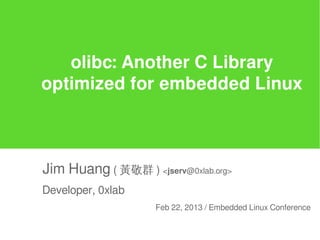



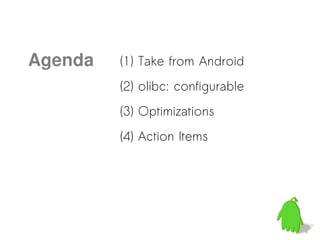





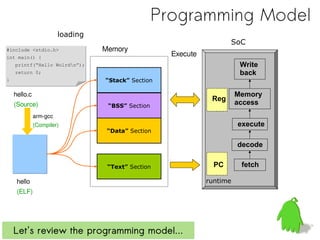

![Programming Model (multi-process)
Multi-Process [Linux] Multi-Process [Android]
application application application
application application application
Framework & VM
middleware & Library
Library
scheduler scheduler
kernel kernel](https://image.slidesharecdn.com/olibc-initial-130222163432-phpapp02/85/olibc-Another-C-Library-optimized-for-Embedded-Linux-13-320.jpg)


![Memory Map [Android pre-4.x]
0x00000000
0x00008000
app_process
0x40000000
Java apps and No memory with execution attribute
resource data
File mapping direction
*.apk,*.jar,*.ttf etc.
Some memory are of execution attribute
Shared lib; libc,
libwecore etc. File mapping direction
various .so files
0xB0000000
/system/bin/linker
Stack
0xBEFFFFFF](https://image.slidesharecdn.com/olibc-initial-130222163432-phpapp02/85/olibc-Another-C-Library-optimized-for-Embedded-Linux-16-320.jpg)


![AddressSanitizer
=================================================================
==7161== ERROR: AddressSanitizer global-buffer-overflow on address 0x2a002194 at
pc 0x2a00051b bp 0xbeeafb0c sp 0xbeeafb08
READ of size 4 at 0x2a002194 thread T0
#0 0x40022a4b (/system/lib/libasan_preload.so+0x8a4b)
#1 0x40023e77 (/system/lib/libasan_preload.so+0x9e77)
#2 0x4001c98f (/system/lib/libasan_preload.so+0x298f)
#3 0x2a000519 (/system/bin/global-out-of-bounds+0x519)
#4 0x4114371d (/system/lib/libc.so+0x1271d)
0x2a002194 is located 4 bytes to the right of global variable 'global_array
(external/test/global-out-of-bounds.cpp)' (0x2a002000) of size 400
Shadow byte and word:
0x05400432: f9
0x05400430: 00 00 f9 f9 int global_array[100] = {-1};
More shadow bytes:
0x05400420: 00 00 00 00 int main(int argc, char **argv) {
0x05400424: 00 00 00 00
0x05400428: 00 00 00 00
return global_array[argc + 100]; /* BOOM */
0x0540042c: 00 00 00 00 }
=>0x05400430: 00 00 f9 f9
0x05400434: f9 f9 f9 f9
0x05400438: 00 00 00 00
0x0540043c: 00 00 00 00
0x05400440: 00 00 00 00
Stats: 0M malloced (0M for red zones) by 35 calls
Stats: 0M realloced by 0 calls](https://image.slidesharecdn.com/olibc-initial-130222163432-phpapp02/85/olibc-Another-C-Library-optimized-for-Embedded-Linux-19-320.jpg)
















